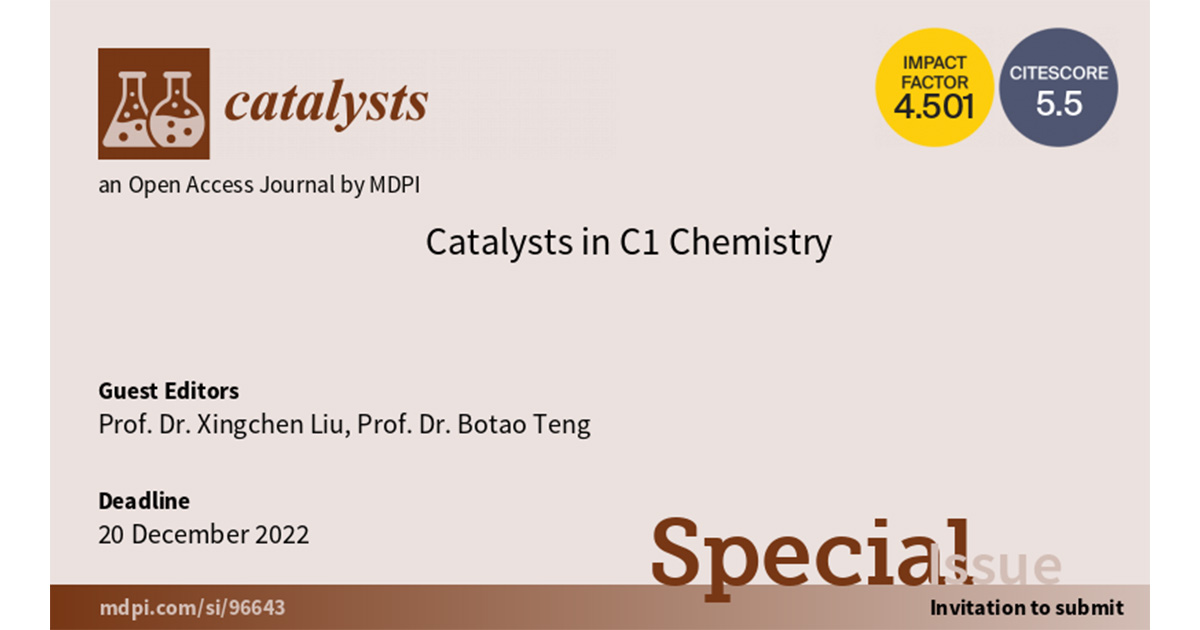Catalysts in C1 Chemistry
A special issue of Catalysts (ISSN 2073-4344). This special issue belongs to the section "Environmental Catalysis".
Deadline for manuscript submissions: closed (20 December 2022) | Viewed by 9522

Special Issue Editors
Interests: multiscale modeling of heterogeneous catalysis in operando conditions; machine learning in heterogeneous catalysis; Fischer–Tropsch synthesis
Interests: structure and reaction mechanism of catalysts; catalysis spectroscopy; reaction dynamics of catalysis; synthesis and structure–property relationship of catalysts
Special Issues, Collections and Topics in MDPI journals
Special Issue Information
Dear Colleagues,
C1 catalysts refer to catalysts that convert molecules containing just a single carbon atom. Historically, concerns about diminishing petroleum supply have given rise to a growing interest in generating synthetic fuels from feedstocks such as coal, biomass, and nature gas through C1 chemistry. The most notable reactions in this category are Fischer–Tropsch synthesis and methanol conversion reactions. More recently, CO2 utilization has attracted enormous attention due to the impacts of greenhouse gas emissions and global climate change. The capture and utilization of CO2 to create valuable products has great potential to lower the net costs of reducing emissions. This Special Issue of Catalysts will attempt to cover the most recent advances in CO selective hydrogenation, CO2 capture and utilizaiton, CH3OH conversion reactions, as well as the conversion of other C1 molecules in thermal, electro-, and photocatalysis. We believe that this topic has both academic and technological importance and offers exciting new advances in C1 catalysts in the design and development of catalysts in the conversion of C1 chemistry.
The format of welcomed articles includes full papers, communications, and reviews. Potential topics include but are not limited to:
- Fischer–Tropsch Synthesis and CO selective hydrogenation into chemicals;
- CO2 capture and utilization;
- Methanol conversion;
- Photocatalytic and electrocatalytic transformations of C1 molecules;
- Theoretical chemistry in C1 conversion including multiscale simulation by different theoretical methods.
Prof. Dr. Xingchen Liu
Prof. Dr. Botao Teng
Guest Editors
Manuscript Submission Information
Manuscripts should be submitted online at www.mdpi.com by registering and logging in to this website. Once you are registered, click here to go to the submission form. Manuscripts can be submitted until the deadline. All submissions that pass pre-check are peer-reviewed. Accepted papers will be published continuously in the journal (as soon as accepted) and will be listed together on the special issue website. Research articles, review articles as well as short communications are invited. For planned papers, a title and short abstract (about 100 words) can be sent to the Editorial Office for announcement on this website.
Submitted manuscripts should not have been published previously, nor be under consideration for publication elsewhere (except conference proceedings papers). All manuscripts are thoroughly refereed through a single-blind peer-review process. A guide for authors and other relevant information for submission of manuscripts is available on the Instructions for Authors page. Catalysts is an international peer-reviewed open access monthly journal published by MDPI.
Please visit the Instructions for Authors page before submitting a manuscript. The Article Processing Charge (APC) for publication in this open access journal is 2200 CHF (Swiss Francs). Submitted papers should be well formatted and use good English. Authors may use MDPI's English editing service prior to publication or during author revisions.
Keywords
- Fischer Tropsch Synthesis and CO selective hydrogenation into chemicals
- CO2 utilization
- Methanol Conversion
- Photocatalytic and electrocatalytic transformations of C1 molecules
- Theoretical chemistry in C1 conversion including multiscale simulation by different theoretical methods
Benefits of Publishing in a Special Issue
- Ease of navigation: Grouping papers by topic helps scholars navigate broad scope journals more efficiently.
- Greater discoverability: Special Issues support the reach and impact of scientific research. Articles in Special Issues are more discoverable and cited more frequently.
- Expansion of research network: Special Issues facilitate connections among authors, fostering scientific collaborations.
- External promotion: Articles in Special Issues are often promoted through the journal's social media, increasing their visibility.
- e-Book format: Special Issues with more than 10 articles can be published as dedicated e-books, ensuring wide and rapid dissemination.
Further information on MDPI's Special Issue polices can be found here.






